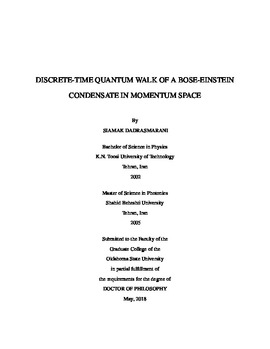| dc.contributor.advisor | Summy, Gil S. | |
| dc.contributor.author | Dadrasmarani, Siamak | |
| dc.date.accessioned | 2019-03-25T21:13:42Z | |
| dc.date.available | 2019-03-25T21:13:42Z | |
| dc.date.issued | 2018-05 | |
| dc.identifier.uri | https://hdl.handle.net/11244/317729 | |
| dc.description.abstract | Randomness is the essence of many processes in nature and human society. It can provide important insights into phenomena as diverse as disease transmission, financial markets, and signal processing. Quantum randomness is intrinsically different from classical stochasticity since it is affected by interference and entanglement. Quantum walks profit from the entanglement that is built up between a walker's position and the "coin" degree of freedom that determines the direction of a walker's motion. This entanglement makes quantum walks promising candidates for the implementation of quantum computational algorithms and as a detector of quantum behavior. While several proof-of-principle quantum walk experiments have recently been implemented, the walk scheme we demonstrate here involves the synthesis of the atom-optics kicked rotor with the dynamics of a state selective ratchet realized with a Bose-Einstein condensate. Here we present a discrete-time quantum walk that uses the momentum of ultra-cold rubidium-87 atoms as the walk space and two internal atomic states as the coin degree of freedom. To implement each step of the walk, i.e. a coin toss followed by a unitary shift operator, we use a microwave pulse, which produces a superposition of two internal states, and a resonant quantum ratchet, which entangles the internal and external degrees of freedom. Our quantum ratchet, whose direction at each step depends on the result of the coin toss, is realized by the atom-optics kicked rotor. We demonstrate the principle features of a standard quantum walk, contrasting them to the behavior of a classical walk. In addition, by manipulating either the walk or coin operator we show how the walk dynamics can be biased or reversed. Furthermore, we show the quantum-to-classical transition in our walk, via randomizing the mixing between the two internal states during each coin toss. Our walk offers distinct advantages arising from the robustness of its dynamics in momentum space, extendability to higher dimensions, and possible dependence on many-body correlations. | |
| dc.format | application/pdf | |
| dc.language | en_US | |
| dc.rights | Copyright is held by the author who has granted the Oklahoma State University Library the non-exclusive right to share this material in its institutional repository. Contact Digital Library Services at lib-dls@okstate.edu or 405-744-9161 for the permission policy on the use, reproduction or distribution of this material. | |
| dc.title | Discrete-time quantum walk of a Bose-Einstein condensate in momentum space | |
| dc.contributor.committeeMember | Rosenberger, Albert Thomas | |
| dc.contributor.committeeMember | Borunda, Mario F. | |
| dc.contributor.committeeMember | Abraham, Eric R. | |
| dc.contributor.committeeMember | Stine, James E. | |
| osu.filename | Dadrasmarani_okstate_0664D_15613.pdf | |
| osu.accesstype | Open Access | |
| dc.type.genre | Dissertation | |
| dc.type.material | Text | |
| thesis.degree.discipline | Photonics | |
| thesis.degree.grantor | Oklahoma State University | |
